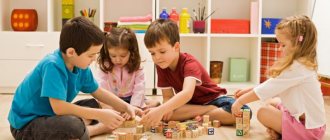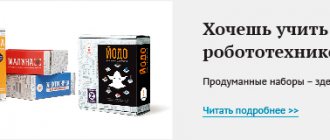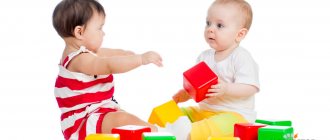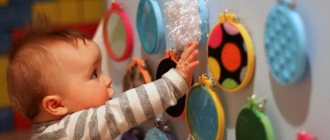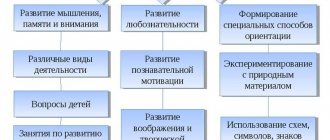One of the important features of a child in the future is the development of thinking today. It is important to start paying attention to this as early as possible.
There is such a thing as a “sensitive period”. This is the optimal stage for developing a particular skill. For children, the period when the foundation is laid is from 1 year to 7 years.
In the article we will talk about the stages of development of thinking in children, methods, and the connection of thinking with other skills.
Features of thinking in preschool age
The brain of a preschooler is mobile and malleable, open to new knowledge. That is why useful habits, the desire to engage in sports, music, theater and art are laid precisely in the preschool period.
In order for a child to analyze and think, it is necessary to constantly set new tasks for him, as well as modernize and complicate the skills he has already acquired.
There are several factors that have a strong influence on a child’s thinking:
- Circle of friends. The older the child, the more children and adults there should be around him. Kindergartens, clubs and sections help with this. The child must observe different behavior patterns of both adults and children.
- Speech development. The child learns to construct sentences and express his thoughts.
- Formation of an analytical worldview. Preschool children are characterized by paying attention to shapes, color, size, spatial arrangement and time frames.
- Acquiring skills and abilities. The child learns to retell, read syllables, and sing.
- Formation of personal qualities. Character, adaptability, initiative, organization - all this is formed as a result of educational activities.
- Formation of self-esteem. A developed child is able to evaluate himself.
- The emergence of self-control. The child learns to manage his behavior and actions.
Stages of development of thinking
- visually effective;
- visual-figurative;
- verbal-logical.
Visual and effective thinking is formed at the age of 1-3 years. When, as a result of his actions, a child, without realizing it, draws conclusions “for the future.” And proof of this are toys, keyboards, and parental gadgets disassembled for spare parts. The purpose of these actions is to know “what’s inside?”
At the age of 3-7 years, visual-figurative thinking is formed. It is during this period that the first signs of analysis appear. For example, having certain skills, a child can already tell what a toy will feel like when he sees it in a store window. Many can already predict the situation.
Closer to 6 years, the first inclinations of verbal and logical thinking appear. At this stage, the child begins to give detailed answers after analyzing information, is able to arrange the sequence of events in the correct order, and can characterize almost any object. Speech is of paramount importance on the development of a child’s thinking.
Types of thinking
Psychologists distinguish the following types of children's thinking:
- objective-active
- up to two years, develops mainly from “spurring” by imagination, the baby examines, disassembles and even breaks toys and household items, but cannot yet explain his actions; - visual-figurative
- from two to four years, appears on the basis of the child’s existing knowledge, the child already understands some images and can use them in the game, for example, plays “to the hospital”; - verbal-logical
- from four to five years and older - depends on the development of speech, which is actively used by the child in play and everyday life; - abstract-symbolic
- develops at the same age, when the child is able to identify some features and signs of things.
Creative thinking is highlighted separately, and it does not depend on the age of the child: both a two-year-old child and a schoolchild can build towers from cubes or practice with a construction set, draw, sculpt, sing and dance.
Mental operations
Observing how a child’s thinking develops, the entire thought process can be divided into stages:
- comparison;
- analysis;
- synthesis;
- generalization.
At the comparison stage, the child learns to find the same in different things, different in the same. During this period, it is appropriate to give “find the differences” pictures and play memory games (start with 6 pairs of pictures, gradually increasing the number).
At the analysis stage, features, qualities, properties, materials and objects used are identified. In his imagination, a child can divide any product into its component parts.
The synthesis stage is closely related to the analysis stage. Without analysis it will not be possible to synthesize. An example of this is reading. Without remembering letters, without understanding how they merge into syllables, a child will not be able to read.
Vivid signs of generalization are the identification of common characteristics of objects and grouping. As soon as a child develops coherent speech and the use of a large number of generalizing concepts, you know that the generalization stage has begun.
How to develop a preschooler's thinking
The development of thinking occurs through play, as this is the leading type of activity. You can beat everything. From a pedagogical point of view, it should be developed in different directions. Involve your child more in housework.
Check out the table; it contains the main types of exercises for developing thinking in children, which we focus on in our classes.
| Types of activities | Description |
| Memory development task | Memorizing image elements, sequence of details, etc. |
| Logic exercises | Find what is missing, identify a pattern using analysis, comparison, reasoning |
| Classification tasks | Sorting, grouping by characteristics, etc. |
| Exercises for concentration | Finding identical properties, differences between objects, images, etc. |
| Tasks for the development of spatial perception | Development of visualization, spatial arrangement, solving puzzles and puzzles |
| Exercise to develop analytical skills | Search for details that are superfluous or not true |
| Tasks for the formation of a strategic approach | Thinking through a whole chain of actions. Analysis of sequences and results |
Characteristics of thinking ↑
Thinking is one of the basic psychological processes. Its formation has been well studied. It has been proven that it is closely related to speech. And it is characterized by the following features:
- search and discovery of new knowledge;
- a generalized reflection of the information received and the surrounding reality;
- analysis of events or objects;
- perception of objects.
As the child grows and socializes, the nervous system and thinking improve. For their development, they will need the help of adults who surround the baby. Therefore, as early as one year of age, you can begin classes aimed at developing children’s cognitive activity.
Important! It is necessary to consider what objects and how the child is ready to work. Educational materials and assignments are selected taking into account the individual characteristics of children.
The thinking characteristics of this age group are determined by the following:
- generalization – the child is able to compare and draw conclusions about similar objects;
- visibility – the child needs to see facts, observe various situations in order to form his own idea;
- abstraction – the ability to separate signs and properties from the objects to which they belong;
- concept - an idea or knowledge about a subject related to a specific term or word.
Systematic mastery of concepts occurs already at school. But groups of concepts are laid down earlier. Along with the development of abstraction, children gradually master inner speech.
Exercises and games to develop thinking in preschoolers
Let's look at options for exercises and games that can be easily used in everyday life by the whole family.
Games for the development of visual and effective thinking
- “Sort into groups” is a game in which the work of the eyes and hands is leading. For example, place large spoons, dessert spoons and tea spoons in front of your child. Ask them to sort them. The child must decide for himself on what principle to do this.
- Game "Build a Row". Cylinder blocks, color plates, heat bottles, flavor bottles, tangram and other materials can be used here. For example, you need to build a row from large to small. Cylinder blocks from the Montessori method are used. Colored plates of the same color, but different shades, must be arranged from darkest to lightest.
- Game "Find a place for the nesting doll." It will require nesting dolls (at least 6 pieces). We arrange the figures in a row at an equal distance from each other. Then we ask the child to close his eyes, remove one figure, and align the rest. The baby opens his eyes and tries to find the place between which figures the matryoshka stood. As the task is completed, the number of components should increase.
Games for the development of visual-figurative thinking
- Game "What does it look like?" There are a lot of variations of it. One of them might be to show an image of a fancy blob. Give your child the opportunity to think about what it is, who it is, what it tastes like, what it smells like, what it does and other signs.
- Game “Say it in one word.” Depending on the age of the child, the approach to identifying objects will change. For children 3-4 years old - simple generalizations such as: furniture, dishes, berries, flowers. For a child aged 5 years, the generalization should be deeper, for example: insects, wild animals, pets, professions, etc. Children 6-7 years old already operate with such concepts as animals of Africa, Asia, fruits of Europe, Asia, etc.
- Game "Give a definition." The child is offered an object that he characterizes. For example, we show a mug that needs to be described: big, dad’s, fragile, glass, etc. And then the child shows you the object, and you characterize it.
Games for the development of verbal and logical thinking
- Game "Collect the picture." It is analogous to puzzles. The child’s task is to assemble a whole picture from several parts. The older the baby, the more details.
- Game "Continue the Row". Draw a chain and a row of beads in a certain sequence: yellow, green, blue, pink, and then repeat the row once and invite the child to continue. The older the child, the more beads there are, and their sizes change.
- "Opposites". A game of matching the opposite. For example, you say cold, but the child picks up hot; wet-dry; black and white and so on.
- Game "Guess what it's about." You consistently describe the subject, and the child guesses what you are talking about. For example: round, striped, sweet, juicy - watermelon.
How to develop thinking in preschool children
How to develop thinking in preschool children
In order to understand how a little person perceives the reality around him, you need to have an idea of how a child comprehends and systematizes information received from the outside world.
Therefore, understanding the patterns of development of thought processes in preschool children will make communication between parents and a small child more productive and enjoyable.
Thinking of preschoolers: stages and features
Visual-effective thinking
In the earliest period of his life, at the age of one and a half to two years, the baby “thinks” with his hands - disassembles, explores, sometimes breaks, thus trying to explore in an accessible form and form his own idea of what surrounds him.
Therefore, we can talk about a visually effective way of thinking. That is, the child’s thinking is completely determined by his active actions aimed at researching and changing the objects around him.
Ways to develop visually effective thinking
At this stage, the main task of parents
is not to interfere with the desire of the little explorer to try everything with his own hands.
Despite the fact that, undoubtedly, in the process of his actions, the baby can break something, break something, damage it, and even injure himself. Therefore, it is important to encourage his desire to learn, while not forgetting about safety measures.
This type of thinking is well trained by toys, the elements of which somehow reflect the result of the child’s actions - sorters, sets for applied activities, activities with different materials - loose sand, cereals, water, snow.
Try to ensure that your child forms a clear connection during the game - “action-result of action”, this will be useful for future lessons in logic and mathematics.
Visual-figurative type of thinking
At the next stage, from three to four years old to first grade, the child actively develops a visual-figurative type of thinking. This does not mean that the previous, visually effective one is being supplanted, no. It’s just that, in addition to the already existing skills of mastering surrounding objects by actively perceiving them with “hands,” the baby begins to think using a system of images. This type of thinking is reflected especially clearly in the child’s emerging ability to draw.
When drawing any object, for example, a house, children rely on their idea of it, on those of its characteristic features (roof, walls, window) that are imprinted in their memory. In this case, the resulting image is not individualized - it is only an image formed in the baby’s mind at a given moment in time.
It is very important that the child enjoys visualizing and embodying in reality the images that arise in his mind.
This is well facilitated by drawing, modeling, design, and appliqué classes.
Verbal - logical thinking
At the age of 5-7 years, preschoolers begin to actively develop the following type of thinking - verbal-logical. The ability not only to report facts, but also to subject them to detailed analysis in verbal form speaks of well-developed verbal and logical thinking.
For example, if you ask a child of three or four years old, “What is a cat?”, he will say: “The cat is Fluff, and he lives in his grandmother’s yard.” A five- to six-year-old child will most likely answer this question like this: “A cat is an animal that catches mice and loves milk.” This answer demonstrates the child’s visual ability to analyze - one of the most important mental operations, which is a kind of “engine” for the development of thinking in preschool children.
Creative thinking
This type of thinking characterizes the ability to be creative—that is, to create new, non-standard solutions. The successful development of a child’s creative abilities will largely depend on the parents’ desire to develop creativity in him.
Unlike previous types of thinking, the creative type is not determined by the factors of growth and formation of the child’s intellectual abilities.
Such forms of mental activity as fantasies and imagination are characteristic of any child and are an essential condition for the emergence of the creative process. It is only important to create an environment in which a little person can develop his creative impulses. Absolutely all types of creativity will help with this: literary, visual, choreographic, musical.
There are no children incapable of creativity; parents of preschoolers should remember this. Even children who are lagging behind in development are able to find original creative solutions to the proposed problems if classes with parents and teachers contribute to this.
Mental operations and their role in the development of thinking in preschoolers
Universal mental operations inherent in human thinking are analysis, synthesis, comparison, generalization and classification. It is the ability to use these operations that determines the development of thinking in preschool children.
Comparison
In order for a child to fully be able to use this category, it is necessary to teach him the skill of seeing the same in different, and different in the same. Starting from the age of two, teach your child to compare and analyze objects by comparing homogeneous features, for example: shape, color, taste, consistency, set of functions, etc.
It is necessary that the child understands the importance of analysis based on homogeneous features and is able to identify and name them.
Expand the horizons of the concepts being compared - let it be not only objects, but also natural phenomena, seasons, sounds, properties of materials.
Generalization
This mental operation becomes available to a preschooler at the age of 6-7 years. A child aged three to four years old can use the words “cup”, “spoon”, “plate”, “glass” very well, but if you ask him to name this entire group of objects in one word, he will not be able to do it.
However, as the vocabulary and coherent speech are filled, the use of generalizing concepts will become accessible to preschoolers, and they will be able to operate with them, expanding their thinking abilities.
Analysis
This way of thinking makes it possible to “dismember” the analyzed object or phenomenon into its constituent components or to identify a number of individual signs and traits characteristic of it.
Ask your child to describe the plant. At the age of 3-4 years, he will most likely point out and name its parts without difficulty: stem, leaves, flower, thus demonstrating his ability to analyze. Analysis can be aimed not only at “dismembering” a concept, but also at identifying exceptional features unique to it.
Synthesis
A mental operation that is the opposite of analysis. If, while analyzing, a child “dismembers” an object, a concept, a phenomenon, then synthesis, as a result of the analysis, will allow him to combine the characteristics obtained separately. This operation is illustrated very well by a preschooler’s mastery of coherent reading skills. From individual elements (letters and sounds) he learns to form syllables, from syllables - words, words form sentences and text.
Classification
Mastering this method of mental action will allow the child to identify the similarities or differences of certain objects, concepts and phenomena. By highlighting one, but, as a rule, essential feature, the baby can classify a group of objects under consideration.
For example, toys can be classified according to the material from which they are made - these are toys made of wood, plastic, soft toys, natural materials, etc.
Exercises to develop analysis, synthesis and classification skills
“What’s extra?”
Place in front of your child several pictures depicting objects that he understands. You can use children's lotto cards, or you can make pictures yourself.
For example, the pictures show the following objects: an apple, candy and a book. The child must analyze and correctly classify these objects. An apple and a candy can be eaten, but a book cannot. This means that the picture with the book in this row will be superfluous.
“Pig in a poke” (we train analysis and synthesis skills)
One of the players (if the child is still small and does not speak very well, let it be an adult) takes a picture from the children's lotto and describes what is depicted on it, without showing it to the other player. However, the object itself cannot be named! The other player must guess, based on the description, what is shown in the picture. Over time, when the child grows up (starting from 4-5 years), you can change roles - let the child describe what is shown in the picture, and the adult player guesses. In this case, not only thinking abilities are trained, but also coherent speech skills.
“Pick a pair” (training analysis, comparison)
You need two sets of children's lotto with the same cards. One child (player) takes a card and, without showing it, explains to the other players what is written on it. Other players, analyzing, offer their own version of the card, which, in their opinion, depicts what the first child described. If the description and the answer match, two identical cards are removed from the game, and the game continues further with the remaining cards.
"What is this?" (analysis, comparison, generalization)
Invite your child to characterize the following vocabulary lines using a generalizing word.
· glass, plate, fork, knife; /dishes/;
· plum, apple, orange, banana; /fruits/;
· sparrow, stork, goose, dove; /birds/;
· cat, pig, rabbit, sheep; /animals, pets/;
· rose, tulip, lily of the valley, poppy; /flowers/.
Come up with vocabulary lines on your own, complicate the tasks over time, move from simple objects to concepts and phenomena (seasons, human feelings, natural phenomena, etc.).
The development of thinking in preschool children is a task, the solution of which directly depends on how successfully the child has mastered and can use the above mental operations.
Activities and games aimed at training them will ensure not only the intellectual development of the preschooler, but the harmonious formation of the personality of the growing child as a whole, because it is developed thinking that distinguishes a person from other living beings.
